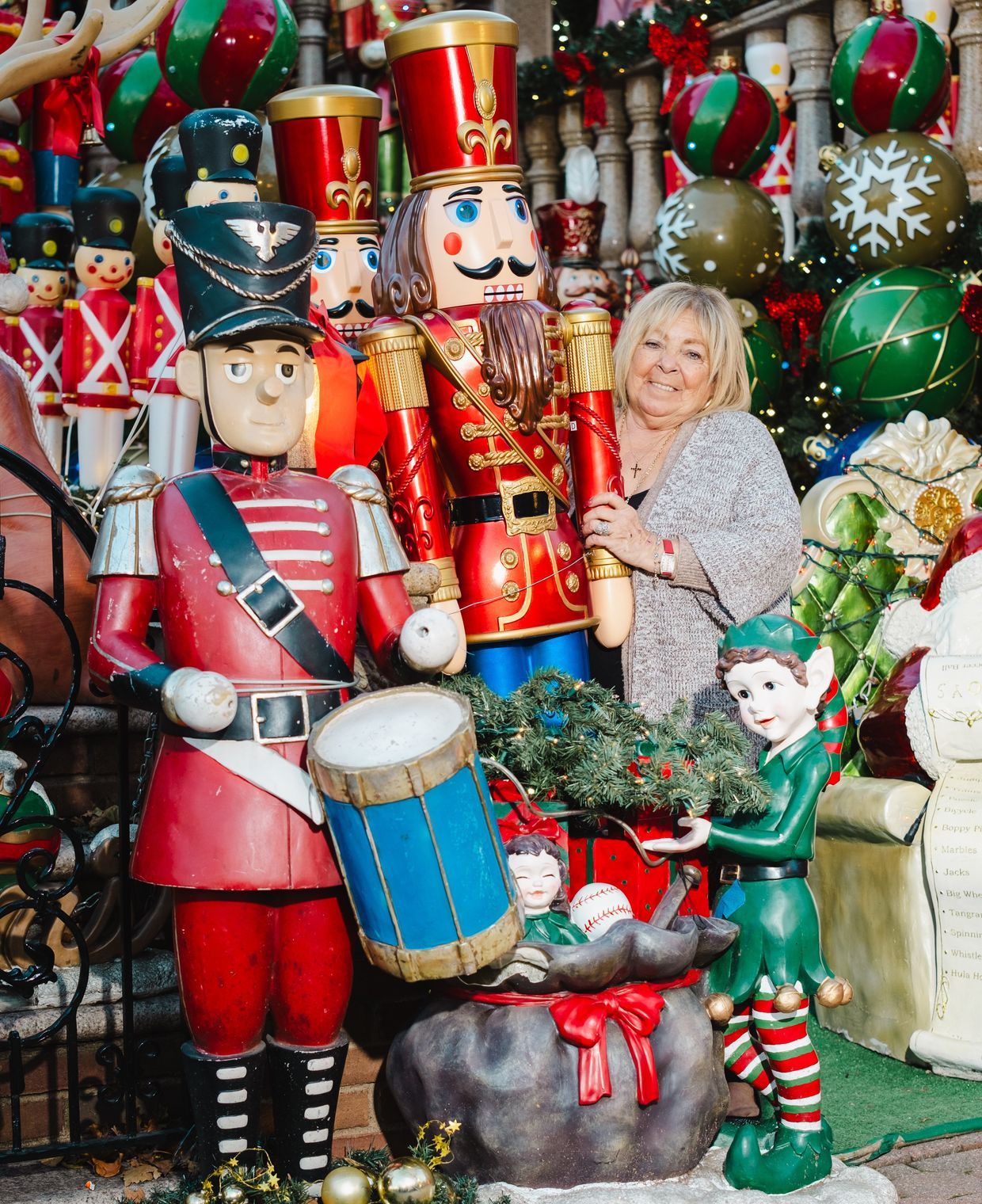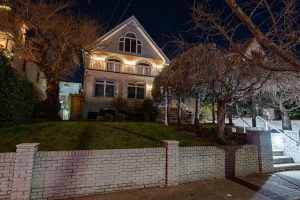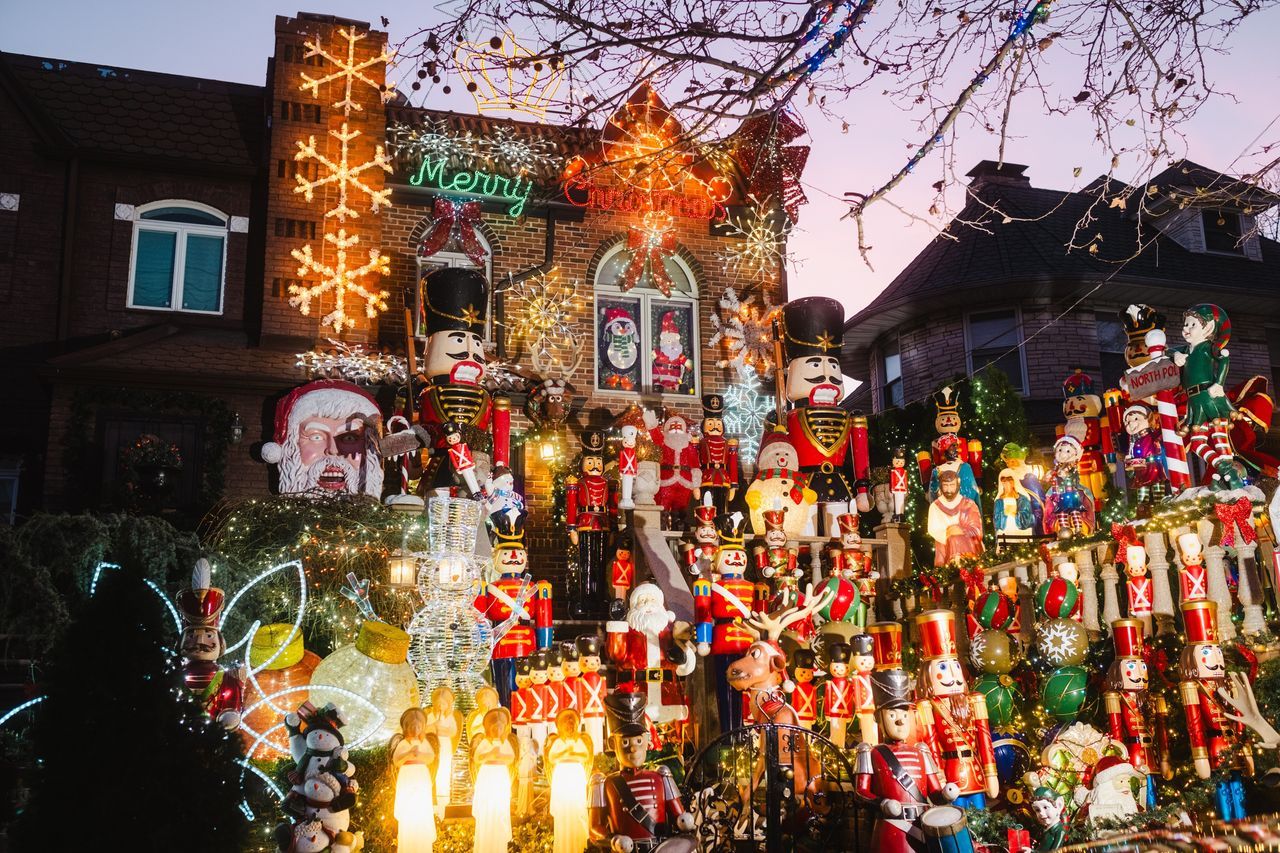At precisely 5:15 p.m. on a recent Tuesday night, a large brick house at the corner of 12th Avenue and 84th Street in Brooklyn, N.Y., is set ablaze with hundreds of twinkling white lights, from the roofline to every window, tree and shrub.
Tour guides congregate outside the house, holding poles with lights attached to help corral their charges, who eagerly snap photos. Police gather at the corner to help control crowds, while trucks selling ice cream and hot chocolate idle nearby.
Welcome to December in Dyker Heights, the New York City neighborhood known for its over-the-top displays of Christmas decorations. Every holiday season, tourists pack the sidewalks of this otherwise quiet neighborhood to gawk at 30-foot-tall snowmen, animatronic reindeer and mansions with virtually every surface blanketed in lights.

The Dyker Heights Christmas lights have been a major tourist attraction since the early 2010s, but the lights are a bit dimmer this year. Many of the families who extravagantly decorated their homes starting in the 1980s are dying or moving away. While many of the newcomers replacing them are excitedly joining in on the fun, others don’t have the time, money or inclination to create the massive holiday displays the area is known for.
“There are less lights this year,” said Patricia Fischetti-Brimigion, a longtime resident who decided not to decorate this year after the deaths of her husband and brother. “A lot of the big homes that did it sold to other people.”
Still, fans are hoping the beloved tradition can survive. Vito LaBella, a community activist and former City Council candidate, grew up in south Brooklyn near Dyker Heights when the area was predominantly Italian-American. He said he was thrilled this year to see one large house decorated with Chinese characters, Koi fish and brightly lighted pandas munching on sparkling green bamboo.
“I just really was heartened by that,” he said, because it suggests that “even after all the Italians have gone, that this tradition may carry on.”
Dyker Heights is a tree-lined neighborhood with top-rated schools and easy access to green spaces such as Dyker Beach Golf Course, said Joseph Baglio, president of Madison Estates Sotheby’s International Realty. In contrast to the typical rows of Brooklyn brownstones, Dyker Heights has a number of grand, free-standing houses on large lots with yards and garages, which lend themselves to elaborate Christmas displays.
“The architecture there is like no other in Brooklyn,” said Tony Muia, owner of A Slice of Brooklyn Bus Tours.
These amenities have long drawn well-to-do local businesspeople, although the lengthy commute to Manhattan has kept it off the radar of many New Yorkers, Baglio said. The priciest home sale in the neighborhood was a $5.237 million deal for a roughly 7,000-square-foot, Mediterranean-style house on 84th Street in 2019, according to public records.
To hear Lucy Spata tell it, the Christmas lights tradition started in the 1980s, when she and her late husband, Angelo Spata, bought their semidetached brick row house for $280,000. “My mother was a very big decorator for Christmas, so we always decorated,” said Spata, 68. When she moved to Dyker Heights from Bensonhurst, however, “Christmas came, and there was nothing but darkness. No lights, nothing. I looked at my husband and my husband looked at me. We said, ‘We have to do something about this.’ ”
The couple started decorating their house inside and out, becoming known for their lavish displays. At first the neighbors complained, but the Spatas were undaunted, hiring a band to play Christmas carols outside their house. “The more they complained, the bigger I went,” Lucy said. “I guess they got tired of complaining, because they all started decorating.”
Each year she festoons her property with hundreds of decorations, keeping them in a storage space during the rest of the year. Her husband died a few years ago, but that hasn’t slowed Lucy down. “He made me promise I wouldn’t stop,” she said.
While some families do the decorating themselves, others pay professionals up to $15,000 to deck the halls, according to local real-estate agent Vito Angelo of Re/Max, who grew up in Dyker Heights. James Bonavita of B&R Christmas Decorators said he has about 60 customers in Dyker Heights.
“In the last 10 or 15 years, it really took off,” said Baglio, attributing the increase in tourist traffic in part to social media. Muia said when he first started doing bus tours of the Dyker Heights Christmas lights in 2006, the decorations drew about 100,000 people each season. Now that figure is 400,000 or more.
Nowadays, “if you don’t like to decorate, you don’t belong here,” Spata says. “If you don’t, and you move here, I suggest for 30 days you go on vacation.”
This year, however, some of the area’s fan favorites have gone dark.
For years, Patricia Fischetti-Brimigion and her husband, Stephen Brimigion, packed their yard on 12th Avenue with blowup characters ranging from Rudolph to Santa to the Incredible Hulk, collecting donations for the nonprofit Community Mayors for Children with Special Needs, said Fischetti-Brimigion, a clinical psychologist. But Stephen died in 2019, and after her brother’s death in October, she opted not to decorate this year.
Fischetti-Brimigion said she noticed the decline in neighborhood decorations starting with the onset of Covid, when many people moved away.
Another past highlight for many visitors was the Polizzotto property, a white-columned house on 84th Street decorated with a 20-foot talking Santa Claus, enormous nutcrackers and rotating carousels. Owner Florence Polizzotto died in 2019. In 2021, the house was sold for $2.3 million. Alfred Polizzotto, her son, said he took half the decorations to his home on Long Island, while his sister took the other half to her property in New Jersey.
The new owner is Shi Yong Chen, a member of the family that owns the Fushimi restaurant chain, according to public records. This year, the house is adorned with a pair of much smaller nutcrackers and some lights, but far less than the Polizzotto display. Chen didn’t respond to requests for comment.
A large 12th Avenue Colonial with a gazebo usually covered in Christmas lights sold in January for $3.3 million, according to public records. Bonavita said the new owners asked for minimal decorations this year, since they plan to raze the roughly 4,380-square-foot house and build a new one. “They said, ‘We’ll do big next year.’ ”
Spata says she encourages newcomers to get involved. “When people move in, I say, ‘I hope you’re going to decorate, because you know what this block is.’ ” But she said she understands that not everyone has the bandwidth for a big display, and said that she suggests that her neighbors do whatever they can. This year, she said she even decorated her neighbor’s property for them.
Sam Ni, a 45-year-old computer-store owner who was born in China and came to the U.S. in 2000, paid $639,800 for his Dyker Heights home in 2014. He said he and his wife, Sharon Chen, chose the neighborhood for its schools, safety and cleanliness. When it comes to Christmas lights, Ni said that although they aren’t Christian, his family has enthusiastically embraced the local tradition. This year, they have a large snowman outside their house, a wreath hanging on the door and lights on the trees in their front yard. “If you live in Dyker Heights, I think everyone needs to try to do that,” he said.
He said he has also noticed that fewer houses seem to be decorated this year. “Before, almost all the houses have that,” he said. “Right now, some houses don’t do anything.”
A year ago, Yiatin Chu moved from Manhattan to the border of Dyker Heights and Bensonhurst to be closer to her daughter’s school. Chu, the president of the nonpartisan political group Asian Wave Alliance, said she was born in Taiwan but came to New York at age 8. Like Ni, she said she isn’t Christian but has a Christmas tree.
Christmas decorations are “very much an American tradition and something that Dyker Heights is known for,” she said. “If you move there, you need to think about doing it, is what I say.” After all, she added, “Everyone likes pretty lights.”
Still, she said the expense and logistical difficulty of elaborate exterior decorations can be a deterrent to people like her. “I love it, but I just can’t bring myself to store the stuff and put it up,” she said. “I appreciate it when other families do it.”
Some home buyers skip houses in prime Dyker Heights to avoid the Christmas-light hoopla, said Baglio of Madison Estates. “They’ll say, ‘I don’t want to be on those blocks,’ ” he said. For most, however, “if they’re coming here, they want to be part of it.”
Vito Angelo, who bought a house in Dyker Heights for $1.6 million in 2022, said the neighborhood’s epic Christmas decorations are one of the reasons he wanted to own a home there. “I want to be part of it,” he said. “It’s nice.”
The popularity of the Christmas lights has also helped raise the neighborhood’s visibility among home buyers who might not otherwise consider homes in south Brooklyn, according to real-estate agent Marvin Chu of the Corcoran Group. “Folks from the upper parts of Brooklyn or Manhattan might never have discovered this area otherwise,” he said.

Anyone purchasing in prime Dyker Heights, however, should be aware that the Christmas lights do come with inconveniences during the month of December, such as traffic and crowds. “It has little downsides,” said Fischetti-Brimigion. “If you drive, it’s hard to get in and out.” If she needs to leave the neighborhood at night in December, she walks to 13th Avenue and takes an Uber, she said. But overall, she said, the decorative extravaganza is “exciting. It’s fun.”
However the neighborhood tradition evolves, Spata’s elaborate decorations aren’t going anywhere. She said that as a condition of inheriting the house, her children must continue decorating the exterior. “As long as they live there, they have to decorate,” she said. “The outside has to be done big.”
Write to Candace Taylor at candace.taylor@wsj.com



